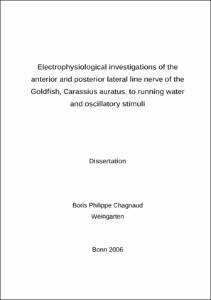Chagnaud, Boris Philippe: Electrophysiological investigations of the anterior and posterior lateral line nerve of the Goldfish, Carassius auratus, to running water and oscillatory stimuli. - Bonn, 2007. - Dissertation, Rheinische Friedrich-Wilhelms-Universität Bonn.
Online-Ausgabe in bonndoc: https://nbn-resolving.org/urn:nbn:de:hbz:5N-09212
Online-Ausgabe in bonndoc: https://nbn-resolving.org/urn:nbn:de:hbz:5N-09212
@phdthesis{handle:20.500.11811/3036,
urn: https://nbn-resolving.org/urn:nbn:de:hbz:5N-09212,
author = {{Boris Philippe Chagnaud}},
title = {Electrophysiological investigations of the anterior and posterior lateral line nerve of the Goldfish, Carassius auratus, to running water and oscillatory stimuli},
school = {Rheinische Friedrich-Wilhelms-Universität Bonn},
year = 2007,
note = {The neural responses of anterior lateral line nerve (ALLN) fibers of goldfish to sinusoidal water motions in still and running water were investigated. In agreement with previous data (Engelmann et al., 2002) two types of fibers were distinguished: type I fibers, which most likely innervate superficial neuromasts, were stimulated by running water (10 cm/s) and, type II fibers, which most likely innervate canal neuromasts, were not stimulated by running water. The responses of type I fibers to sinusoidal water motions were masked in running water whereas responses of type II fibers were not masked. The degree of response masking increased with increasing flow velocity. Moreover, the ratio between responses that were masked in running water (type I) and those that were not masked (type II) increased with increasing flow velocity. Fibers exposed to unidirectional water flow showed a continuum of flow sensitivity and not two separate populations of flow sensitive and flow insensitive fibers as might be expected from previous results and theoretical considerations. Most nerve fibers responded with an increase in discharge rate, irrespective of flow direction (head-to-tail and tail-to-head flow). Thus fibers showed no directional sensitivity. Frequency spectra of water motions quantified with particle image velocimetry (PIV) and spectra of the firing rate of lateral line fibers showed an increase in amplitude below 10 Hz under flow conditions. This suggests that the neuromasts responded to the flow fluctuations that developed under flow conditions, but not to the d.c. flow. Thus it is unlikely that the spike trains of individual fibers code for the direction and velocity of a constant flow. Spike trains of ALLN fibers stimulated by a Kármán vortex street (KVS) showed that low frequency stimuli can still be encoded under running water. In terms of spike rate there was no difference between the KVS and the running water condition. However, if exposed to vortex stimuli, spike train frequency spectra showed reproducible peaks at the vortex shedding frequency. Any change in the vortex shedding frequency evoked by a change in either cylinder diameter or water flow velocity shifted the reproducible peaks of the neuronal data into the expected direction. Thus the data show that information about the frequency composition of flow fluctuation is preserved in the spike trains under flow conditions despite the fact that the fibers do not code for the direction and velocity of the flow.},
url = {https://hdl.handle.net/20.500.11811/3036}
}
urn: https://nbn-resolving.org/urn:nbn:de:hbz:5N-09212,
author = {{Boris Philippe Chagnaud}},
title = {Electrophysiological investigations of the anterior and posterior lateral line nerve of the Goldfish, Carassius auratus, to running water and oscillatory stimuli},
school = {Rheinische Friedrich-Wilhelms-Universität Bonn},
year = 2007,
note = {The neural responses of anterior lateral line nerve (ALLN) fibers of goldfish to sinusoidal water motions in still and running water were investigated. In agreement with previous data (Engelmann et al., 2002) two types of fibers were distinguished: type I fibers, which most likely innervate superficial neuromasts, were stimulated by running water (10 cm/s) and, type II fibers, which most likely innervate canal neuromasts, were not stimulated by running water. The responses of type I fibers to sinusoidal water motions were masked in running water whereas responses of type II fibers were not masked. The degree of response masking increased with increasing flow velocity. Moreover, the ratio between responses that were masked in running water (type I) and those that were not masked (type II) increased with increasing flow velocity. Fibers exposed to unidirectional water flow showed a continuum of flow sensitivity and not two separate populations of flow sensitive and flow insensitive fibers as might be expected from previous results and theoretical considerations. Most nerve fibers responded with an increase in discharge rate, irrespective of flow direction (head-to-tail and tail-to-head flow). Thus fibers showed no directional sensitivity. Frequency spectra of water motions quantified with particle image velocimetry (PIV) and spectra of the firing rate of lateral line fibers showed an increase in amplitude below 10 Hz under flow conditions. This suggests that the neuromasts responded to the flow fluctuations that developed under flow conditions, but not to the d.c. flow. Thus it is unlikely that the spike trains of individual fibers code for the direction and velocity of a constant flow. Spike trains of ALLN fibers stimulated by a Kármán vortex street (KVS) showed that low frequency stimuli can still be encoded under running water. In terms of spike rate there was no difference between the KVS and the running water condition. However, if exposed to vortex stimuli, spike train frequency spectra showed reproducible peaks at the vortex shedding frequency. Any change in the vortex shedding frequency evoked by a change in either cylinder diameter or water flow velocity shifted the reproducible peaks of the neuronal data into the expected direction. Thus the data show that information about the frequency composition of flow fluctuation is preserved in the spike trains under flow conditions despite the fact that the fibers do not code for the direction and velocity of the flow.},
url = {https://hdl.handle.net/20.500.11811/3036}
}






